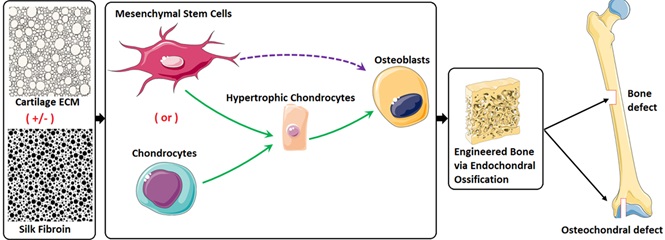description
Bone engraftment techniques to treat large bone defects involve implantation of allogenic bone grafts as a replacement tissue but are constrained on poor integration and functional anastomosis for ingrowth of vasculature from the host tissue. In proportionate many unresolved factors are to be addressed in advancing the clinical outcome for treating fracture non-unions, osteonecrosis, osteoporosis. Tissue engineering strategies hold promise in promoting bone regeneration. Nevertheless, the common approach in bone tissue engineering is by stimulating the osteogenesis route for regenerating bone which still remains an ineffective approach. Mimicking the natural process of bone formation through a developmental mechanism for formation of long bones called endochondral ossification has been envisioned from the commencement of research in the field of bone tissue engineering. In the current proposal, we propose a strategy for bone regeneration with naturally derived biomaterials incorporating extracellular matrix derived from cartilage (CD-ECM) as a template. We hypothesize that bone regeneration through a cartilaginous intermediate template onto solid biomaterials will produce a neotissue that mimics the native bone in its structure and functionality. To test this hypothesis we will compare bone regeneration from the proposed model to the gold-standard bone allografts used in clinics. CD-ECM incorporated biomaterials embedding hypertrophic chondrocytes are evaluated for their mineralized matrix formation in vitro with biochemical analysis and histological evaluation. Further, by non-destructive analysis micro-computed tomography (µCT) monitoring generated 3D segmented images and biomechanical testing of the scaffolds are evaluated together with computational finite element modelling simulations to determine the stiffness, strength of the engineered bone. The CD-ECM incorporated biomaterials are then implanted with or without hypertrophic chondrocytes ectopically in a mouse model for de novo mineralized matrix formation. The bone formation is further assessed by biochemical, µCT, biomechanical, computational modelling. This interdisciplinary approach would aid in a developmental engineering process instructing bioresponsive scaffolds to recapitulate native bone repair mechanisms.
Cooperation partners
- Karl Landsteiner Privatuniversität für Gesundheitswissenschaften
- Ludwig Boltzmann Institut - Experimentelle und Klinische Traumatologie

Details
| Duration | 01/01/2018 - 31/12/2021 |
|---|---|
| Funding | Bundesländer (inkl. deren Stiftungen und Einrichtungen) |
| Program |
Life Science Call NFB

|
| Department | |
| Principle investigator for the project (University for Continuing Education Krems) | Vivek Jeyakumar, PhD MSc |
| Project members |
Mag. Eugenia-Paulina Niculescu-Morzsa
|
Publications
Jeyakumar, V.; Amraish, N.; Niculescu-Morzsa, E.; Bauer, C.; Pahr, D.; Nehrer, S. (2021). Decellularized Cartilage Extracellular Matrix Incorporated Silk Fibroin Hybrid Scaffolds for Endochondral Ossification Mediated Bone Regeneration. International Journal of Molecular Sciences, 22(8): doi.org/10.3390/ijms22084055
Lectures
Silk Fibroin Reinforced Decellularized Cartilage ECM Hybrid Scaffolds for Endochondral Bone Regeneration
Frontiers in Silk science and technology, Trento, Italy, 12/06/2019
Cartilage Derived Extracellular Matrix Incorporated Silk Fibroin Hybrid Scaffolds for Endochondral Ossification Mediated Bone Tissue Regeneration
TERMIS 2019 EU, Rhodes, Greece, 23/05/2019
Interchange in culture supplementation from human serum to platelet-rich plasma achieves both proliferation and matrix turnover of chondrocytes
5th TERMIS WORLD CONGRESS, Kyoto, Japan, 02/09/2018
Enhancing the redifferentiation potential of OA chondrocytes in collagen type I hydrogels by supplementing platelet-derivatives
8th World Congress of Biomechanics, Dublin, Ireland, 08/07/2018